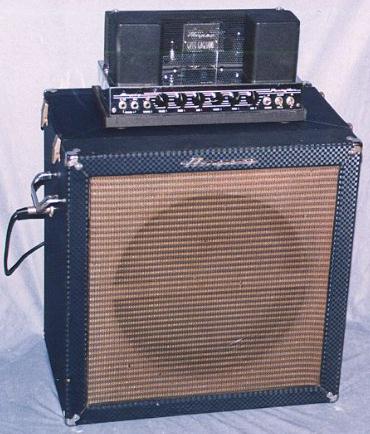
FACTOIDS & TRIVIA
In late 1963, Ampeg seized an opportunity to capitalize on the popularity of the B-15N by introducing a larger, more powerful portaflex bass amp - the B-18N. As its name implies, the B-18N had an 18 inch speaker and shared the B-15N's preamp circuit. At 60 watts, the B-18N had twice the power of the B-15N. Though it never attained the popularity of the B-15N, it did last until the end of 1967. It also had a brilliant design feature that was used on all portaflexes through the 1960s. The speaker was connected to the amp via a cable hardwired to the chassis. Instead of using a ¼ inch phone jack as most manufacturers did, Ampeg used a 4-pin XLR plug. The multi-pin connection employed the use of four pins and the speaker cable used four conductors. Two conductors carried the "hot and cold" leads for the speaker signal. The other two were an extension "loop" of the standby circuit. By bridging two of the pins in the speaker cabinet, the connector acted as a second standby switch. When unplugged, the circuit was open and the amp remained in the Standby mode. If a player forgot to connect the speaker jack to the cabinet, the amp could not be switched out of standby. Therefore, this feature was a failsafe mechanism which was used to ensure that a player wouldn't send the power tubes into runaway mode, resulting in a fried output transformer or worse. For 50 cents, Ampeg would also personalize the light-up, lucite logo of any Portaflex.
AMPEG B-18N PORTAFLEX AMP (1966)

Power Amp: Tube; 2 x 7027A, 60 watts RMS
@ 8 ohms
Preamp: Tube; 2 x 6SL7, 1 x 7199
Rectifier: Tube; 1 x 5AR4
Speakers: 1 x 18" Cleveland (ceramic magnet)
Channels: 2; 2 inputs for Channel 1 (Guitar, Bass), 1 input for Channel 2 (Instrument)
Effects: None
Controls: Bass, treble, volume for each channel
Dimensions: 24 H x 24 W x 18 D inches
Weight:
83 lb
Back to the Ampeg Pix Menu